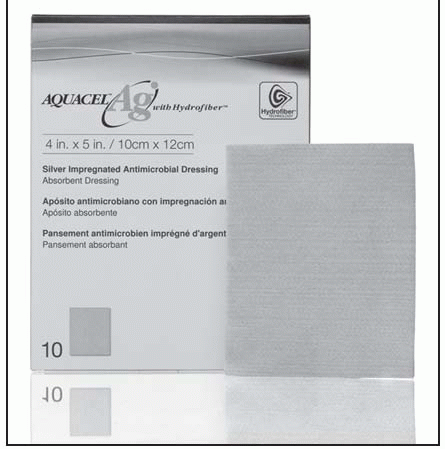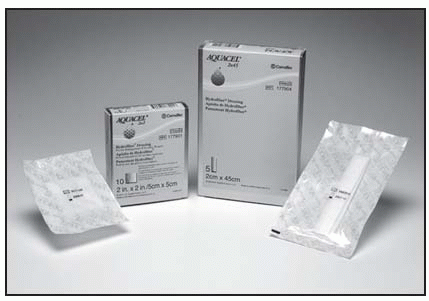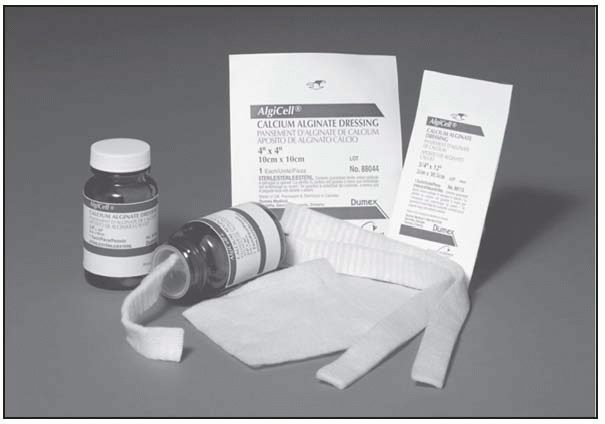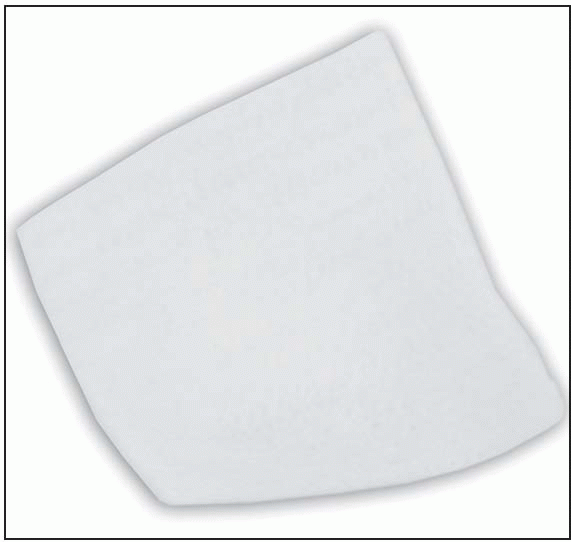Alginates
Action
Alginates are derived from brown seaweed. The products are composed of soft, nonwoven fibers shaped as ropes (twisted fibers) or pads (fibrous mats). Alginates are absorbent and conform to the shape of a wound. When packed, an alginate interacts with wound exudate to form a soft gel that maintains a moist healing environment. An alginate can absorb up to 20 times its weight.
Indications
To manage partial- and full-thickness, draining wounds; wounds with moderate to heavy exudate; tunneling wounds; infected and noninfected wounds; and “moist” red and yellow wounds
Advantages
Absorb up to 20 times their weight
Form a gel within the wound to maintain a moist healing environment
Facilitate autolytic debridement
Fill in dead space
Are easy to apply and remove
Disadvantages
Are not recommended for wounds with light exudate or dry eschar
Can dehydrate the wound bed
Require a secondary dressing
HCPCS code overview
The HCPCS codes normally assigned to alginate wound covers or other gelling fiber dressings are:
A6196—pad size <16 in2
A6197—pad size >16 in2 but <48 in2
A6198—pad size >48 in2
The HCPCS code normally assigned to alginate wound fillers or other gelling fiber dressings is:
A6199—wound filler, per 6″ (15 cm).
ALGICELL Calcium Alginate
Derma Sciences, Inc.
Action
ALGICELL Calcium Alginate dressings are highly absorptive, soft, white, and sterile. They form a soft gel in contact with wound fluids to maintain a moist healing environment.
Indications
To manage moderately to highly exuding partial- and full-thickness wounds; may be used for smaller wounds or to pack deep wounds (rope)
Contraindications
Contraindicated for third-degree burns
Contraindicated for surgical implantation
Application
Clean wound with PrimaDerm Dermal Cleanser or saline solution, according to facility policy.
Apply ALGICELL to the wound bed.
Loosely pack deeper wounds.
Cover the dressing with an appropriate secondary dressing.
Removal
Remove the secondary dressing.
Gently rinse the affected area to remove remaining gel.
Reapply a new dressing daily or as indicated by amount of exudate and facility policy.
AlgiSite M Calcium Alginate Dressing
Smith & Nephew, Inc.
Wound Management
Action
AlgiSite M is a calcium-alginate dressing that forms a soft gel that absorbs wound exudate. AlgiSite M uses the proven benefits of moist wound management. The exudate produces a gel upon contact with the alginate fibers to create a moist wound surface environment. This helps prevent eschar formation and promotes an optimal moist wound environment. The dressing allows wound contraction to occur, which may help reduce scarring, and also allows the gaseous exchange necessary for a healthy wound bed.
Indications
Under the care of a health care professional, to manage full- and partial-thickness leg ulcers, pressure ulcers, diabetic foot ulcers, and surgical wounds; for over-thecounter applications, to manage lacerations, abrasions, skin tears, and minor burns
Contraindications
Not for use until the packing in cavities and sinuses has been removed
Not for use on very lightly exuding wounds
Not for use on patients allergic to alginates
Application
Cleanse the wound in accordance with normal procedures.
Choose a dressing that’s slightly larger than the wound and place it in intimate contact with the wound base, making sure that the entire surface is covered. It may be best to use the alginate strip if the wound is deep or undermined. To avoid maceration of the surrounding skin, cut the AlgiSite M to the size of the wound, or fold any dressing material overlying the wound into the wound.
Apply using an appropriate dressing technique.
Cover with an appropriate retention dressing. Wound exudate will evaporate from the gel surface; the secondary dressing shouldn’t hinder this evaporative process where exudate is heavy.
Removal
Generally, dressings should be changed daily in heavily draining wounds, reducing to twice weekly (or weekly) as healing proceeds.
If the dressing isn’t easily removed, moisten it with saline, then remove.
To remove AlgiSite M, use tweezers, forceps, or a gloved hand to gently lift the dressing away—the high wet strength generally allows it to remain in one piece. The dressing may adhere if used on a very lightly exuding wound. Removal of the dressing is facilitated by saturating the wound with saline.
AQUACEL Ag Hydrofiber Dressing with Silver*
ConvaTec
How supplied
Dressing: | 2″ × 2″; A6196 4″ × 5″, 6″ × 6″; A6197 8″ × 12″; A6198 |
Ribbon with Strengthening Fibers: | 0.39″ × 18″; A6199 |
 |
Action
AQUACEL Ag Hydrofiber Dressing with silver is an advanced technology, sterile, single use wound dressing comprised of sodium carboxymethylcellulose and ionic silver (Ag+). It is a soft and conformable dressing that remains integral when wet or dry. This highly absorbent dressing interacts with wound exudate and forms a soft gel that maintains a moist environment for optimal wound healing and easy removal with little or no damage to healing wounds. The ionic silver gives AQUACEL Ag dressing its silver-gray appearance and broad-spectrum antimicrobial properties.
Indications
To manage wounds at risk of infection; partial-thickness (second-degree) burns; diabetic foot ulcers; venous stasis ulcers, arterial ulcers, and other leg ulcers; pressure ulcers (partial- and full-thickness); surgical wounds left to heal by secondary intent; traumatic wounds prone to bleeding, such as those that have been mechanically or surgically debrided; oncology wounds with exudate, such as fungoides-cutaneous tumors, fungating carcinoma, cutaneous metastasis, Kaposi’s sarcoma, and angiosarcoma.
Contraindications
Not for use on patients who are sensitive to or who have had an allergic reaction to the dressing or its components.
Application
Clean the wound with water or saline. Apply the dressing to shallow wounds with an adequate overlap (at least 3/8″ [1 cm]) overlap of the wound edges. For deep wounds, loosely pack ribbon or sheet into wound to about 80% of the depth of the wound to accommodate swelling of the dressing, leaving a small overhang (at least 1_ [2.5 cm]) to facilitate removal.
For dry wounds, place the AQUACEL Ag dressing in the wound and then wet with sterile saline over the wound area only. The vertical absorption properties of the dressing will help to maintain the moist area over the wound only and reduce the risk of maceration. Cover the dressing with a moisture-retentive dressing to avoid drying out the dressing and subsequent dressing adherence to the wound.
Cover and secure with an appropriate dressing.
Removal
AQUACEL Ag dressing is designed to be easy to remove without leaving residue or causing trauma to the wound bed. In the unlikely event of adhesion to the wound bed, the dressing can be easily removed by soaking.
AQUACEL Hydrofiber Wound Dressing*
ConvaTec
How supplied
Dressing: | 2″ × 2″, 4″ × 4″; A6196 6″ × 6″; A6197 |
Ribbon with strengthening fibers: | 0.39″ × 18″, 0.75″ × 18″; A6199 |
 |
Action
AQUACEL Hydrofiber Wound Dressing is a soft, sterile, nonwoven pad or ribbon dressing made from sodium carboxymethylcellulose fibers. This conformable and absorbent dressing forms a soft gel that creates a moist wound environment that supports the healing process and autolytic debridement and allows for nontraumatic removal.
Indications
To manage exuding wounds, pressure ulcers, leg ulcers, abrasions, lacerations, incisions, donor sites, oncology wounds, first- and second-degree burns, and surgical or traumatic wounds that have been left to heal by secondary intent; may be used for wounds that are prone to bleeding, such as mechanically or surgically debrided wounds, donor sites, and traumatic wounds; may also be used to facilitate the control of minor bleeding.
Contraindications
Contraindicated for use in patients with sensitivity to this dressing or its components.
Not intended for use as a surgical sponge.
Application
AQUACEL Hydrofiber Wound Dressings are sterile and should be handled appropriately.
If necessary, debride the wound prior to application, then cleanse it with an effective cleansing agent such as SAF-Clens AF dermal wound cleanser or normal saline solution.
Apply AQUACEL Hydrofiber Wound Dressing to the wound site, and cover with an appropriate secondary dressing, such as a moisture-retentive dressing.
Change the dressing when it becomes saturated with exudate or when good clinical practice dictates.
Dressing may remain in place for up to 7 days.
Removal
Remove the secondary dressing gently, according to the product’s package insert.
Remove the AQUACEL Hydrofiber Wound Dressing and discard.
Without disrupting the delicate granulation tissue, irrigate the wound with SAF-Clens AF dermal wound cleanser or normal saline solution to remove any residual gel.
Redress the wound with a new dressing, and cover with a secondary dressing as previously described.
CarboFLEX Odor Control Dressing*
ConvaTec
Action
CarboFLEX is a sterile nonadhesive dressing with an absorbent wound-contact layer (containing alginate and hydrocolloid), an activated charcoal central pad, and a smooth, water-resistant top layer.
Indications
To manage acute and chronic wounds; may be used as a primary dressing for shallow wounds or as a secondary dressing over wound fillers for deeper wounds; may also be used on infected malodorous wounds along with appropriate therapy and frequent monitoring of the wound
Stay updated, free articles. Join our Telegram channel

Full access? Get Clinical Tree





